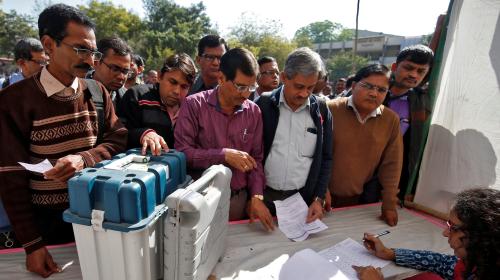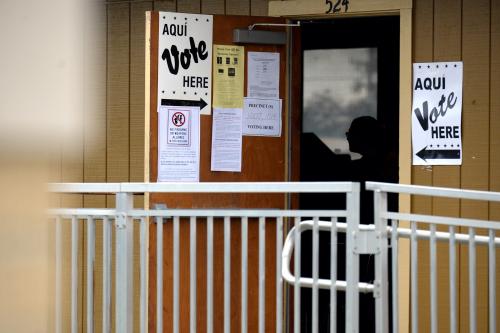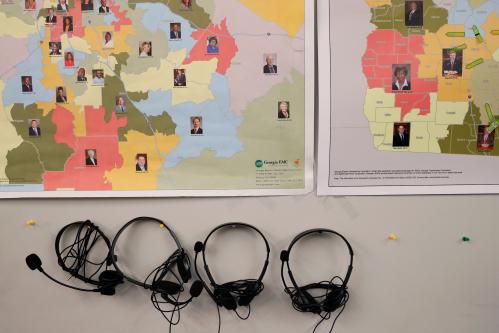This post is part of “Cybersecurity and Election Interference,” a Brookings series that explores digital threats to American democracy, cybersecurity risks in elections, and ways to mitigate possible problems.
 On June 27, the House passed a bill that would bolster America’s high-tech voting infrastructure with a low-tech fix: paper. Introduced by Rep. Zoe Lofgren (D-CA-19), the SAFE Act requires that all voting machines involve “the use of an individual, durable, voter-verified paper ballot of the voter’s vote.” While the inclusion of paper ballots may seem like a technological step backward, the SAFE Act’s affinity for paper is not a quirk. Election security experts from Harvard, Stanford and the Brennan Center for Justice all recommend the phasing out of paperless voting, and twelve of the thirteen Democratic candidates who have declared a position on election security support mandating the use of paper ballots.
On June 27, the House passed a bill that would bolster America’s high-tech voting infrastructure with a low-tech fix: paper. Introduced by Rep. Zoe Lofgren (D-CA-19), the SAFE Act requires that all voting machines involve “the use of an individual, durable, voter-verified paper ballot of the voter’s vote.” While the inclusion of paper ballots may seem like a technological step backward, the SAFE Act’s affinity for paper is not a quirk. Election security experts from Harvard, Stanford and the Brennan Center for Justice all recommend the phasing out of paperless voting, and twelve of the thirteen Democratic candidates who have declared a position on election security support mandating the use of paper ballots.
Yet despite expert consensus, political activism, and availability of funding, opposition in the Republican-controlled Senate makes it unlikely that the SAFE Act or any paper ballot standard will be implemented by 2020. With no method to verify votes in the case of software or hardware failure, paperless voting machines represent a large vulnerability. Failure to act on election security risks not only a loss of trust in the next election, but in the democratic process as a whole.
The role of paper ballots in voting machines
Broadly speaking, there are three classes of voting machines. Today, the most commonly used devices are optical scan machines. In this system, poll workers use an optical scanner, a device which registers marks on a page, to process voters’ paper ballots, storing the results electronically. This system has a paper audit trail by design, and election officials can compare the paper ballots each voter fills out with the scanner’s tabulation.
A less common class of voting machines is ballot marking devices, in which voters select their choice on a screen. Rather than storing the selections electronically, the machine then prints a paper ballot to be either hand counted or scanned by a computer.
The only widely used machines that do not incorporate paper as a necessary part of their design are direct-recording electronic (DRE) machines. When using DREs, voters select their choices onscreen, transmitting the data straight into the voting machine’s memory. While DREs can record voters’ choices onto paper, many do not. These DREs that completely forgo paper ballots are among the most vulnerable parts of American election infrastructure.
From paper to paperless and back again
America’s turn to paperless voting has its roots in the confusion caused by ambiguous ballot marking during the 2000 election. In its aftermath, Congress passed the Help America Vote Act (HAVA), which allocated $3.9 billion to help voting precincts replace old lever and punch card systems with state-of-the-art equipment. While computer scientists warned Congress at the time of the dangers of paperless systems, HAVA passed both chambers of Congress without requiring that funds be used to purchase systems that utilize paper ballots.
When HAVA came into effect, DREs were seen by many as the most accessible, convenient, and high-tech option. The fully-electronic systems displayed text in multiple languages, accommodated the hearing- and visually-impaired, and simplified logistics for poll workers. According to the New York Times, over two-thirds of precincts used DREs after HAVA.
The DRE honeymoon was brief, with problems surfacing as early as the 2002 election. Concerns over paperless DREs came to a head in the 2004 election in which Democratic activists and politicians claimed that error with the newly installed DRE machines had swung the election in Bush’s favor.
High-tech voting systems need low-tech paper
Without a paper audit trail, it can be difficult to detect errors or breaches in the voting machine’s software or hardware, possibly allowing an incursion into American voting systems to go unnoticed. Even if an error is found, performing an audit of a paperless system can be difficult or impossible given a lack of redundant records to verify vote totals.
These concerns are not hypothetical: At the 2018 DEF CON hacking conference, a computer scientist easily manipulated a paperless DRE system such that every vote for one candidate registered as a vote for their opponent. Even more troubling was that without a paper audit trail, it was not possible to know the true count for each candidate.
The vulnerability of paperless systems became a real issue during the tight Georgia gubernatorial and Texas senate races of 2018. In both cases, paperless DRE machines allegedly switched votes for Democratic candidates into Republican votes. While this was likely a software glitch, the lack of a paper audit trail confuses what the intended votes were, and whether these allegations were true.
Why have these machines not been replaced yet?
As controversy over paperless DREs has mounted, states have gradually adopted systems that use a paper audit trail. However, as of the 2018 midterm election, 12 states representing 150 electoral college votes use paperless DREs as their primary election infrastructure in some of their precincts. Many election officials would like to replace insecure machines but are limited by shortages in funding. While the aforementioned SAFE Act would provide a much needed $600 million with a continuing $175 million every two years for election machine upgrade and renewal, it may take a new Senate or president to enact new election infrastructure standards.
In the meantime, those drafting proposals in Congress on the campaign trail would do best to remember the mistakes of HAVA and listen to the recommendations of election security experts for voting machines. Experts are currently sounding the alarm over certain types of ballot marking devices, and even DREs with paper audit trails.
Should lawmakers committed to election security have the opportunity to enact substantive legislation, they should take great care in specifying the security requirements for voting machines that precincts be permitted to buy with allocated funds. Needlessly employing vulnerable infrastructure will not only undermine the integrity of the 2020 election but will tear into the very fabric that undergirds democratic society, the electoral process.










Commentary
Why paper is considered state-of-the-art voting technology
August 14, 2019